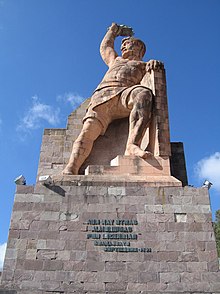El Pípila
El Pípila [ el Pipila ] ( dt . "The turkey ") was the nickname of Juan Jose de los Reyes Martinez Amaro (* 3. January 1782 in San Miguel Allende , † 25. July 1863 ibid), a Mexican miners and National hero who became famous for destroying the gates of the Alhóndiga de Granaditas during the Mexican War of Independence . However, its existence is controversial.
Live and act
Little is known about his life, only that he was born as the son of Pedro Martínez and María Rufina Amaro in 1782 in San Miguel de Allende and worked in one of the numerous mines in the area. Its nickname is said to derive from its blotchy, turkey-like face. He is said to have been of indigenous descent.
In 1810 an uprising against Spanish colonial rule broke out in Dolores Hidalgo under the leadership of Miguel Hidalgo , which marked the beginning of the Mexican War of Independence. The rebels reached San Miguel de Allende a few days later, where they were also joined by Juan José Martínez.
On September 28, 1810, they attacked Guanajuato , the capital of the administrative unit ( Intendencia ). The defenders, led by the Intendente Juan Antonio de Riaño y Barcena, holed up in the Alhóndiga de Granaditas , the fortress-like granary of the city. The rebels fought their way to the granary, but got caught up in the defensive fire there.

The only starting point for the attackers to penetrate into the building were the wooden gates. El Pípila is said to have tied a large, flat stone on his back as protection against the bullets of the defenders and crawled to the gates of the Alhóndiga de Granaditas . He is said to have ignited the wooden portals with a torch and fire accelerator . A little later the gates were destroyed, which enabled the storming of the granary and thus the capture of Guanajuato.
El Pípila is said to have participated in other actions of the uprising, only to later become a miner again. He died on July 25, 1863 in his hometown.
Aftermath
Since the storming of the Alhóndiga de Granaditas was the first major military victory of the mostly Indian rebels against the Spaniards, this event established itself in the Mexican national consciousness and El Pípila became a national hero.
In the 1990s, however, he disappeared from Mexican school books along with other folk heroes. He also did not appear in a historical television series in 2010, after he appeared in a similar program in 1996 as the heroic conqueror of the Alhóndiga de Granaditas . The reason for this was that the existence and the "heroic deed" of El Pípila was denied by some historians because they were not verifiable. Only the destruction of the gates by fire is historically certain, but this could also have been achieved by several insurgents together. The question became the subject of public debate, which also extended to the fundamental importance of such characters and events for Mexican historical awareness and national identity.
Monuments and El Pípila as namesake
In 1939 a monument to Juan José Martínez was erected in an exposed location above Guanajuato. The monumental Pípila by Juan Fernando Olaguíbel depicts the miner with a raised torch and can be seen from almost the entire city. The interior pedestal shows the inscription "... aún hay otras Alhóndigas por incendiar" (German: "... there are other Alhóndigas to light up").
In his hometown of San Miguel de Allende there is also a smaller statue that shows the folk hero with a torch and stone. There is also a school named after him in town. A district of Tijuana is called El Pípila .
A Mexican tanker built in 2007 was named El Pípila .
Individual evidence
- ↑ a b c Heriberto García Rivas: 150 Biografias de Mexicanos Ilustres . 7th edition. Editorial Diana, 1998, ISBN 978-968-13-2562-6 , pp. 129 (Spanish).
- ^ David F. Marley: The Caribbean, Mexico, and Central America (= Historic Cities of the Americas: An Illustrated Encyclopedia . Volume 1 ). ABC-CLIO, Santa Barbara 2005, ISBN 978-1-57607-027-7 , Guanajuato, pp. 243 (English, limited preview in Google Book Search [accessed on May 24, 2012]).
- ↑ Dinah Stratenwerth: Otros mexicanos hablan lenguas indígenas - The construction of indigenous identity in current Mexican school books . GRIN Verlag, no location 2005, ISBN 978-3-638-42825-5 , p. 64–66 ( limited preview in Google Book Search [accessed June 26, 2012]).
- ↑ Guanajuato minimiza omisión del Pípila en serie. El Universal, September 8, 2010, accessed June 25, 2012 (Spanish).
- ↑ 21 ° 0 '52.22 " N , 101 ° 15' 15.88" W.
- ↑ 20 ° 53 '54.7 " N , 100 ° 45' 10.99" W.
- ↑ 20 ° 54'9 " N , 100 ° 44'47.9" W.
- ↑ 32 ° 30 ′ N , 116 ° 53 ′ W.
- ↑ Homepage of the owner (Spanish) ( Memento of the original dated November 3, 2013 in the Internet Archive ) Info: The archive link was inserted automatically and has not yet been checked. Please check the original and archive link according to the instructions and then remove this notice.
| personal data | |
|---|---|
| SURNAME | El Pípila |
| ALTERNATIVE NAMES | Martínez Amaro, Juan José de los Reyes (real name, Spanish) |
| BRIEF DESCRIPTION | Mexican miner and national hero |
| DATE OF BIRTH | January 3, 1782 |
| PLACE OF BIRTH | San Miguel de Allende , Mexico |
| DATE OF DEATH | July 25, 1863 |
| Place of death | San Miguel de Allende , Mexico |
